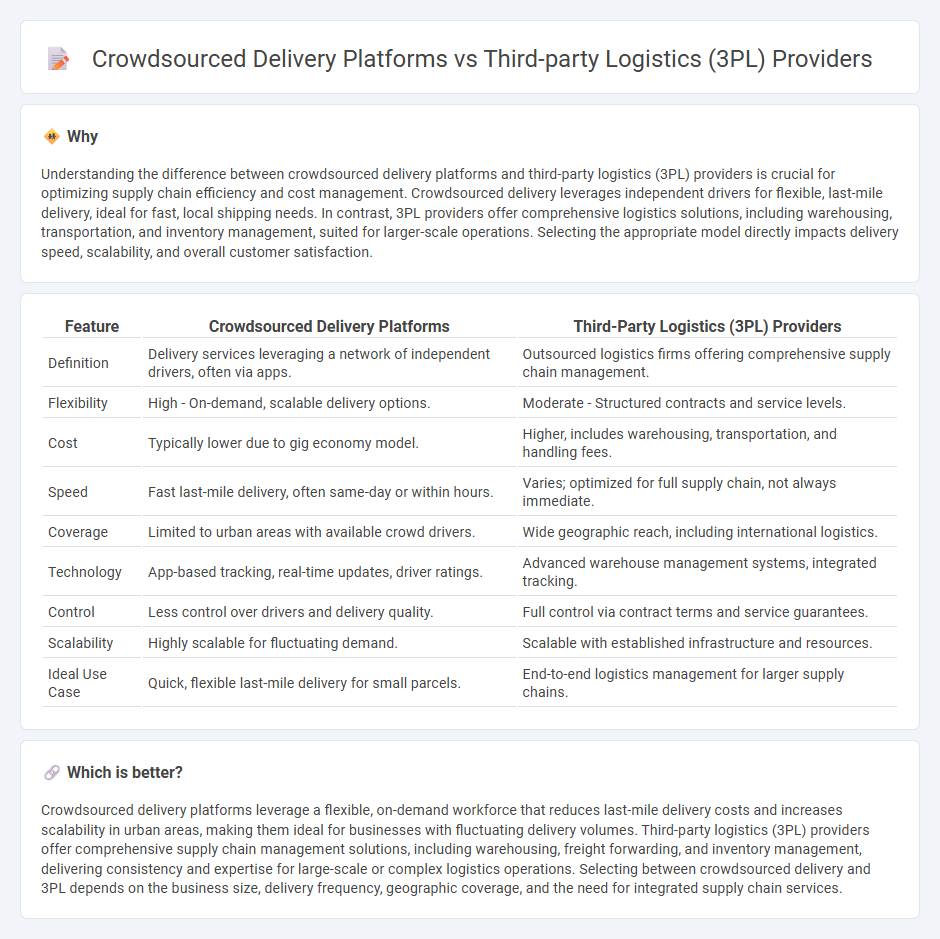
Crowdsourced delivery platforms leverage decentralized networks of individual couriers to offer flexible, real-time last-mile delivery solutions, often reducing costs and increasing delivery speed for e-commerce businesses. Third-party logistics (3PL) providers deliver comprehensive supply chain management, including warehousing, transportation, and fulfillment services, suited for scaling operations and meeting complex logistics demands. Explore the key differences and strategic benefits of each approach to optimize your logistics operations.
Why it is important
Understanding the difference between crowdsourced delivery platforms and third-party logistics (3PL) providers is crucial for optimizing supply chain efficiency and cost management. Crowdsourced delivery leverages independent drivers for flexible, last-mile delivery, ideal for fast, local shipping needs. In contrast, 3PL providers offer comprehensive logistics solutions, including warehousing, transportation, and inventory management, suited for larger-scale operations. Selecting the appropriate model directly impacts delivery speed, scalability, and overall customer satisfaction.
Comparison Table
| Feature | Crowdsourced Delivery Platforms | Third-Party Logistics (3PL) Providers |
|---|---|---|
| Definition | Delivery services leveraging a network of independent drivers, often via apps. | Outsourced logistics firms offering comprehensive supply chain management. |
| Flexibility | High - On-demand, scalable delivery options. | Moderate - Structured contracts and service levels. |
| Cost | Typically lower due to gig economy model. | Higher, includes warehousing, transportation, and handling fees. |
| Speed | Fast last-mile delivery, often same-day or within hours. | Varies; optimized for full supply chain, not always immediate. |
| Coverage | Limited to urban areas with available crowd drivers. | Wide geographic reach, including international logistics. |
| Technology | App-based tracking, real-time updates, driver ratings. | Advanced warehouse management systems, integrated tracking. |
| Control | Less control over drivers and delivery quality. | Full control via contract terms and service guarantees. |
| Scalability | Highly scalable for fluctuating demand. | Scalable with established infrastructure and resources. |
| Ideal Use Case | Quick, flexible last-mile delivery for small parcels. | End-to-end logistics management for larger supply chains. |
Which is better?
Crowdsourced delivery platforms leverage a flexible, on-demand workforce that reduces last-mile delivery costs and increases scalability in urban areas, making them ideal for businesses with fluctuating delivery volumes. Third-party logistics (3PL) providers offer comprehensive supply chain management solutions, including warehousing, freight forwarding, and inventory management, delivering consistency and expertise for large-scale or complex logistics operations. Selecting between crowdsourced delivery and 3PL depends on the business size, delivery frequency, geographic coverage, and the need for integrated supply chain services.
Connection
Crowdsourced delivery platforms leverage a network of independent drivers to fulfill last-mile deliveries, complementing third-party logistics (3PL) providers by enhancing scalability and flexibility in supply chain operations. Third-party logistics companies integrate crowdsourced delivery solutions to optimize route efficiency and reduce transportation costs while improving customer satisfaction with faster parcel distribution. This symbiotic relationship enables 3PL providers to adapt dynamically to fluctuating demand and expand their delivery reach without the overhead of maintaining a large permanent fleet.
Key Terms
Outsourcing
Third-party logistics (3PL) providers offer comprehensive supply chain outsourcing solutions, including warehousing, transportation, and inventory management, designed to streamline operations and reduce costs. Crowdsourced delivery platforms outsource last-mile logistics by leveraging a network of independent couriers, providing flexibility and speed for on-demand delivery services. Explore how outsourcing strategies differ between 3PL providers and crowdsourced platforms to optimize your logistics operations.
Scalability
Third-party logistics (3PL) providers deliver scalable solutions by leveraging established networks, warehousing, and transportation resources to efficiently handle fluctuating shipment volumes. Crowdsourced delivery platforms offer rapid scalability through flexible workforce engagement, enabling quick response to demand spikes without substantial fixed costs. Explore in-depth comparisons to understand which model best suits your business scalability needs.
Source and External Links
What is a 3PL? Third-party logistics definition, process, and resources - A third-party logistics provider (3PL) helps companies optimize supply chain and logistics by managing inventory, warehousing, order fulfillment, transportation, and sometimes customs, allowing businesses to focus on growth while streamlining operations.
Guide to understanding third-party logistics (3PL) - Maersk - 3PL providers manage comprehensive logistics services including warehousing, order fulfillment, and transportation, distinguishing themselves from freight forwarders by covering broader supply chain functions to improve efficiency and customer experience.
3PLs, Explained: The Complete Guide to Third-Party Logistics - RXO - A 3PL arranges or handles supply chain functions like shipping, storing, and packing, with businesses outsourcing these tasks to 3PLs for efficiency, expertise, and cost savings, with models varying between asset-based and non-asset-based providers.
 dowidth.com
dowidth.com